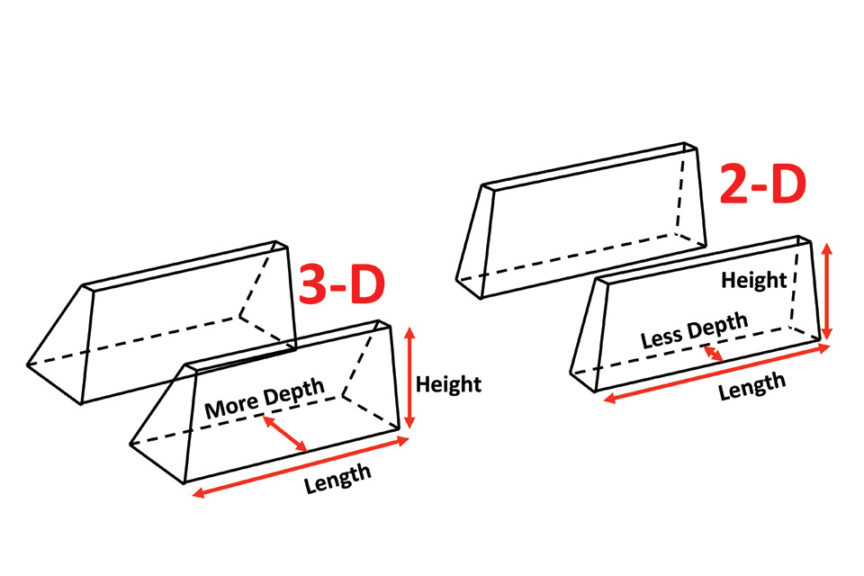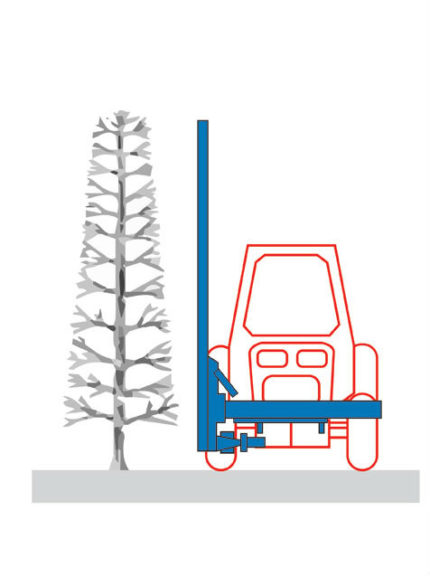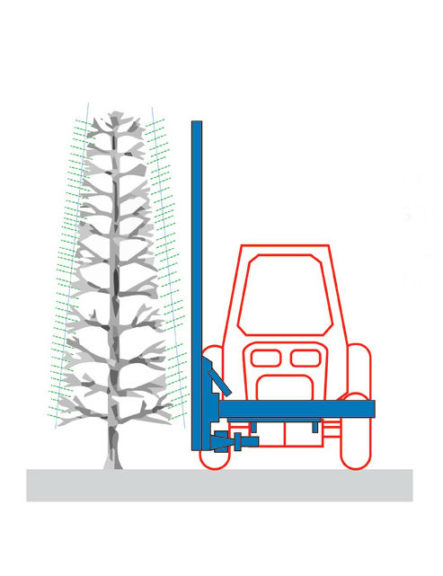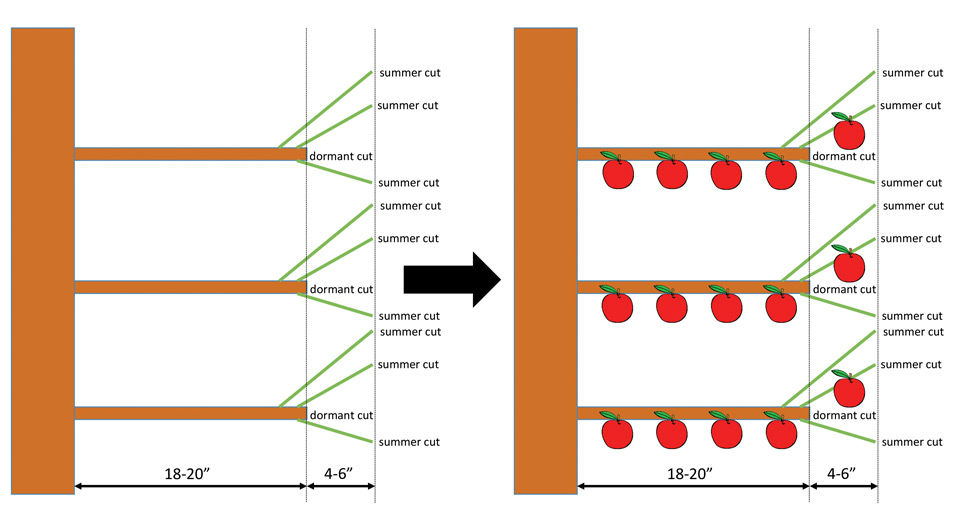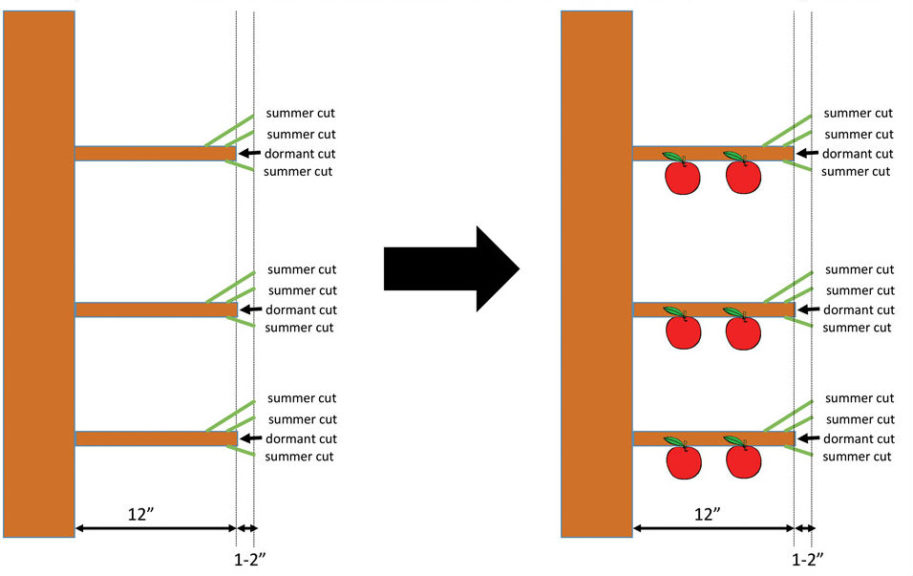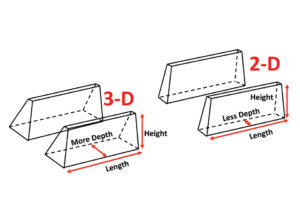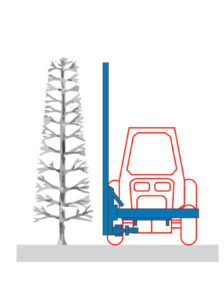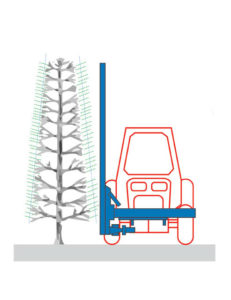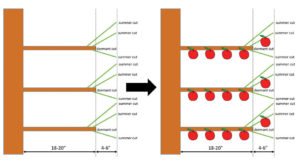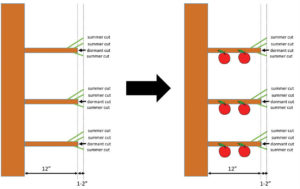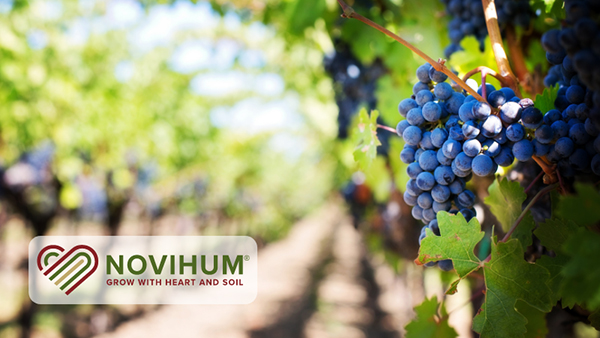Tips to Transition to an Apple Fruiting Wall System
When managed correctly, a 3-D spindle apple system at maturity should give a narrow, tall fruiting wall with high fruit quality due to good light exposure in the narrow canopy. However, 3-D spindle orchards that have not been properly managed have produced dense “bushy” canopies, especially for vigorous trees on fertile soil conditions.
Stumbling Blocks to Canopy Management
In some cases, it has been a challenge for you because the minimal pruning concept for the first four or five years has been easily misunderstood, and as a consequence, it has delayed the renewal pruning process of big limbs. This lack of systematic pruning for the lower, middle, and top portions of a single tree has created excessive shading and loss of fruitfulness, especially in the lower fruiting zones of your orchard, closer to the ground.
The growth habit of cultivars — such as ‘McIntosh’ and all ‘Fuji’ strains — has challenged your management of a 3-D spindle tree. Tall trees are not easy to reach without the use of ladders or platforms for pruning and other orchard tasks. Canopy uniformity is less consistent when winter pruning is only done by hand with ladders.
Finally, limb bending is required, but seldom practiced in the Northeast, for vigorous cultivars like ‘Fuji,’ ‘Macoun,’ or ‘Linda Mac.’ Feathers that are not tied down soon after planting will develop as strong upwardly arched limbs and will be problematic for your 3-feet in-row spacing of a 3-D Spindle-shaped apple tree. These strong feathers will require severe (and unfortunately unneeded) limb removal pruning at an early age, which invigorates the tree and makes long-term canopy containment even more problematic.
Transitioning from 3-D to 2-D
In the last few years, more Northeastern apple growers have adopted mechanical pruning in their orchards. Mature 3-D spindle orchards on a dwarfing rootstock that used to have a significant amount of big limbs and were less productive and uniform have been transitioned or converted to 2-D fruitful canopies via mechanical pruning (Figure 1).
Step 1: The first part of this transition or conversion strategy is for you to manually remove unproductive, big limbs and get renewals through winter pruning. This pruning effort of 2 to 4 cuts per year (during 2, 3, or even 4 winters to prepare the orchard for mechanical winter or “pink” pruning) has been conducted in “calm” moderate-growing orchards with the aim of shaping the trees.
Step 2: The second part of the strategy is to form a square box (Figure 2) by mechanical pruning at the end of the dormant season or at pink (to prevent a little bit the regrowth) to pre-form your trees into a shape or “box.” You can hedge vertically or semi-angled depending on your planting spacing. Your orchard should receive an Apogee program to control vegetative growth as the canopy transition or conversion is started.
Step 3: The third part of the strategy is for you to follow the mechanical dormant or pink pruning with a mechanical summer pruning the same season and every following summer (Figure 3).
Once your orchard has completed the transition, manual dormant pruning should be continued and the canopy improved through the removal of any existing big limbs, if any. You should conduct precise and detailed pruning in the low, middle, and top portion of the canopy every year, ideally with platforms.
It is important to note that with mechanical pruning – conducted during the winter, at “pink”, or during the summer – does not mean hand pruning is not needed or is less important. On the contrary! Hand pruning can be improved and is critical especially for your in-row spacing via hedging as it shapes your trees and the fruit wall for winter pruning. You should not expect or try to save manual winter pruning costs by incorporating the use of mechanical pruning.
Mechanical Pruning Tips for Tall Spindle System
With a tall spindle tree and a row spacing of 12-feet (3-by-12-foot planting spacing), your mechanical winter or pink pruning should be done 18 to 20 inches from the trunk to form the box. Then, from the pre-formed box, hedge the 1-year-old shoots that grow during the season at 22 to 26 inches from the trunk, leaving approximately a semi-angled 4-foot wide wall at the base of your canopy.
There is usually from 14 to 16 planar/horizontal fruiting units on one side of the canopy, each containing four apples and sometimes one more apple at the base of 1-year-old shoots, after mechanical summer pruning (Figure 4).
Mechanical Pruning Tips for Super Spindle System
With a super spindle tree and a row spacing of 11-feet (2-by-11-foot planting spacing), your mechanical winter or pink pruning should be done 12 inches from the trunk to form the box. Then, from the pre-formed box, hedge the 1-year-old shoots that grow during the season at 13 to 14 inches from the trunk, leaving approximately a 2-foot wide vertical wall at the base of your canopy.
There is usually from 18 to 20 planar/horizontal fruiting units on one side of the canopy, each containing two apples. Keep in mind, there will be no production of fruit in 1-year-old shoots, after mechanical summer pruning (Figure 5).
When to Hedge or Not in the Summer?
The effect of timing on mechanical summer pruning on 1-year-old shoots with 12 to 15 leaves has been studied in June, July, and August. The sidewall shearing treatments did not induce vigorous shoot regrowth regardless of the timing of the mechanical pruning. However, with the earliest timing – in early June – we saw the development of short re-growths (approximately 8 inches) with a terminal bud, which resulted in a flower bud next spring. Hedging in July saw regrowth of about 5 inches and at the August timing, there was no regrowth at all. There were no significant differences in return bloom among the different timings of mechanical summer pruning the following year.
So when should you hedge your trees? We encourage you to target your mechanical summer pruning time based on the fruit-size characteristics of the apple cultivar instead of the exact number of leaves per shoot at a particular time during the growing season. This new timing approach to mechanical summer pruning has become a more practical method for some Northeastern fruit growers.
For large fruited varieties such as ‘Honeycrisp’ – where we intentionally want to control or reduce an excessive fruit size at harvest and especially in a rainy summer – we recommend an “early” timing for mechanical summer pruning and a “late” timing for small fruited varieties such as ‘Gala’ to avoid a negative effect on crop size reduction before harvest. Medium-size fruited varieties should be mechanically summer pruned after ‘Honeycrisp’ and before ‘Gala’ to have the same controlling effect on fruit size.
In New York weather conditions, a mechanical summer pruning program should be started for ‘Honeycrisp’ as early as June 15-20 and for ‘Gala’ approximately 4-5 weeks later. In some cases, a ‘Gala’ block could be even hedged 7-10 days before harvest to facilitate the use of harvest platforms.
Benefits of a Narrower Canopy for Your Orchard
The transition or conversion of a 3-D spindle-shaped canopy to a 2-D fruiting wall is well-suited to the majority of Northeastern apple cultivars. With some cultivars, the system may involve a 2 stem tree (bi-axis) or a 3-stem tree (tri-axis) to better manage vigor. It could also allow you to have a more economical production of a similar quantity and quality of fruit (size, color, and eating quality) as from current mature spindle single trees.
Potentially, the size and color of your fruit could be more uniform as a result of better light penetration and distribution. Your water volume needed for good spray coverage for pest control could also be reduced. The uniformity of your chemical thinning could also be improved and the fruit wall could be thinned mechanically with a string thinning machine as long as you reduce the potential spreading of fire blight in your orchard during blossom.
The 2-D fruit wall concept will help you increase the performance of motorized platforms, future harvest equipment and robotics, and your worker efficiency. To take full advantage of these advances in mechanization, new orchards using spindle single trees should be established at a spacing of 2 to 2.5 feet by 11 or 11.5 feet. The leaders or shoots of multileader trees should be spaced 18 to 20 inches in the in-row spacing.
You should use 12-foot posts for trellising, a correct post spacing of not more than 30 feet apart, a minimum of four, five, or six wires (spaced not more than 24 to 26 inches apart) and a vertical element as a wire or a string tie to support the leader (for a single spindle tree) or several leaders (for a multileader tree).
A 2-D Canopy is a Smarter Decision for You Because:
- Fruiting canopy structure is more efficient and simplified
- Light penetration and distribution is improved
- Fruit color and size is more uniform
- Final pack out is increased (more dollars/acre) for a high value/high yielding cultivar
- Hand pruning, hand thinning, and hand picking are improved
- The benefits of orchard mechanization are maximized (including mechanical weed control, use of string thinners, use of platforms for several orchard tasks, robotics, tunnel sprayers)
- The sustainability of the entire fruit production system is increased (less use of PGRs, less spraying volume, faster leaf drying, reduced drift)
- It becomes a more friendly fruit production system to multi-task nets, SSCD (Solid Set Canopy Delivery System)
3-D to 2-D Spindle-shaped canopies
Why?
- If you want to make a mature 3-D spindle orchard more uniform, efficient, narrower, and fully suitable for orchard mechanization
When?
- Start today, the sooner the better, the conversion won’t happen instantly
- If you misunderstood the minimal pruning concept
- If you delayed renewal pruning too much
- If you have done a poor pruning job
- If you have created a dense “bushy” canopy
How?
- Via detailed and precise manual and mechanical dormant and summer pruning
- Set the box once you have removed all big limbs through renewal pruning
- The entire process of conversion can take until 3-4 years





